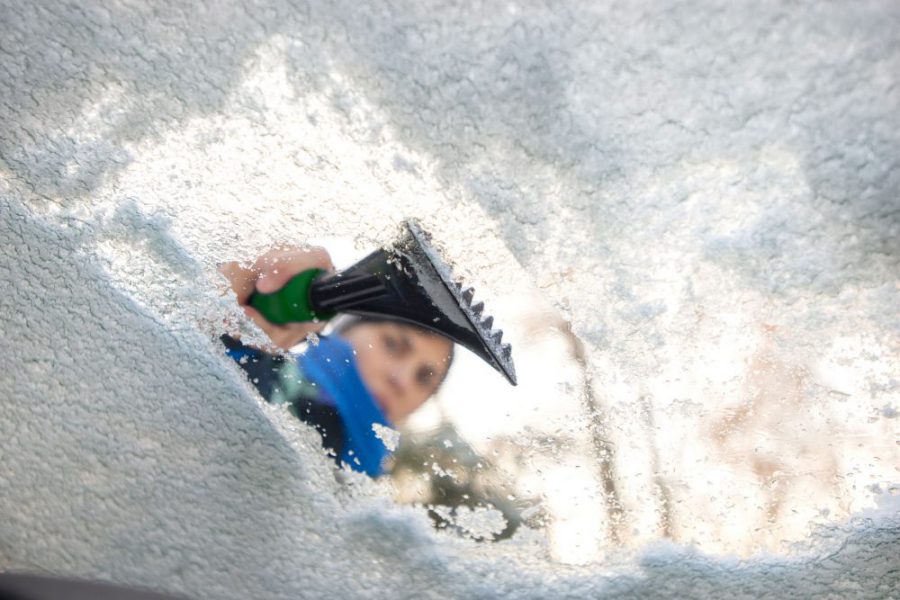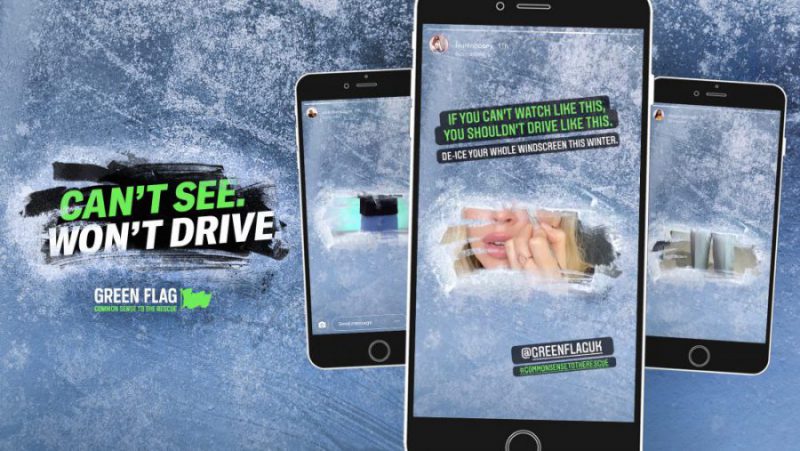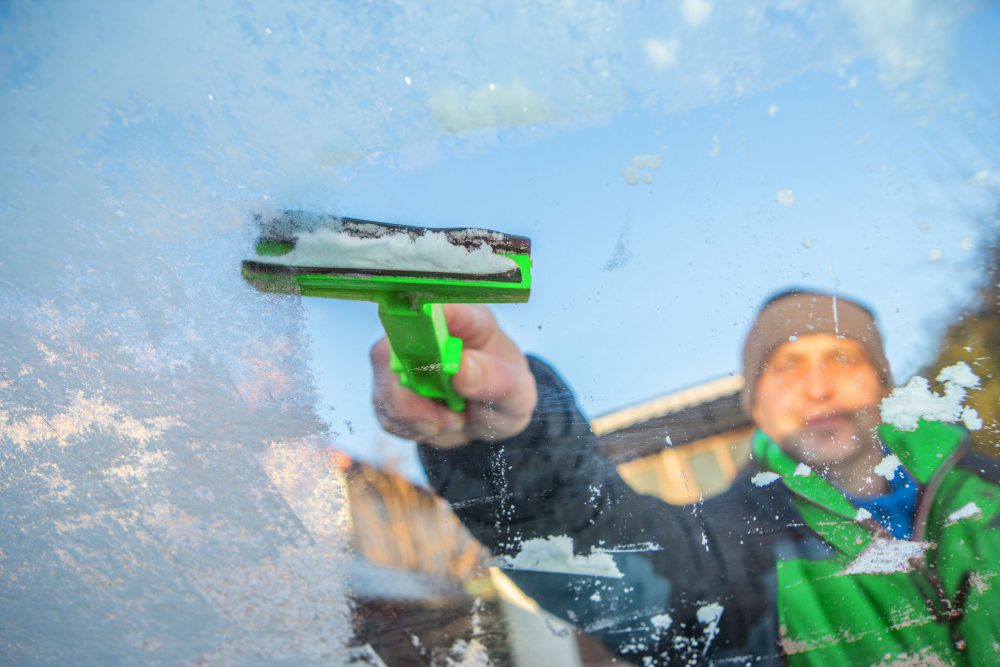
Over a third of UK drivers regularly get behind the wheel without having fully de-iced their vehicle. Not only is this dangerous, it’s actually against the law.
So, as part of our Can’t See, Won’t Drive campaign, we’ve put together some expert advice on how to de-ice your car safely, even in the toughest conditions.
How to de-ice your car
Use a scraper. The most effective way of de-icing cars’ windows is still with a scraper. It’s always best to use one that’s designed for the job. There are stories of people who swear by credit cards and even old CD cases. The danger with these is they may scratch the screen. A proper ice scraper will allow you to shift the ice quickly and effectively.
Try a de-icer spray. If you don’t fancy using a scraper, you can also use de-icer sprays, which are an easy way of getting the job done.
De-ice all of your windows. 42% of drivers only de-ice their windscreen before setting off, but you’ve got to de-ice all your windows, mirrors, and lights to be safe.
Never drive looking through a porthole scraped in the ice on your windscreen. Hazards come at us from all angles when we’re on the road. It’s important that we can see all around us, so make sure you clear the ice from the side windows as well as the entire windscreen.
12% of UK drivers don’t keep a de-icer in their car at all times over winter. Remember, if you don’t have a clear windscreen, you could even face a fine. So, make sure you’ve got all the gear you need.

How not to de-ice your car
Don’t try to de-ice your windows by running your windscreen wipers. It’ll cause excessive wear to the blades, and won’t even shift the ice.
Don’t pour boiling water over your windscreen. It will certainly be very effective at melting the ice, but it’s also a very effective way of causing your screen to crack. If you’ve got a small chip or some damage that you may not have noticed, the boiling water will get into it and the sudden expansion will turn that tiny chip into a rapidly spreading crack.
Finally, don’t believe all the hacks you read online, especially the one that involves getting an old plant sprayer and putting a salt water mix in it. Salt is highly corrosive, so your paintwork won’t thank you for it.

Spray de-icers are very effective tools for the job
Remote heating and electric vehicle technology
Depending on your car, you may not even need to follow the steps listed above. Your car may do all the hard work for you.
Some vehicles now include technology that lets you heat up the vehicle remotely. Give the order and your vehicle can gently warm up, clearing away any ice from the windows and mirrors, and you’ll be good to go in no time.
There are certain electric and hybrid vehicles that can warm up the car while it’s plugged in to charge. This means you’ll have a full battery and a full view of everything around you, even on the chilliest winter morning.
What to do if your locks or brakes freeze up
When the thermometer really does drop below zero, locks can freeze up. One way of thawing them is to boil a kettle, leave it to cool for 10 minutes, then pour it over the lock.
Parking brakes can stick on too. This is because moisture freezes on the surface of the metal components in the mechanism housed inside the back wheels. If you can, pour a kettle of hot water through the spokes of your rear wheels to free it.
Advice if you drive a diesel
Diesel engines can be difficult to start in the winter because diesel is more susceptible to cold weather than petrol. Diesel relies on the fuel being compressed in the cylinder and the heat this generates to ignite. But when an engine is very cold, the engine absorbs that heat, making it difficult for the fuel to burn. To get over this, diesels have things called glow plugs. These ignite the fuel even when conditions are freezing cold.
First thing’s first: when you turn the ignition on, an orange light with a symbol like a curly wire will appear on the dash (left). This light indicates that the glow plugs are heating up. When the light goes out, they’re hot enough to ignite the fuel. When you turn the key the engine should fire easily.
If starting the engine is still difficult in the cold, it might be sensible to take the car in for a service. A new fuel filter may well cure the problem.
One last thing…
When you’re de-icing your vehicle, watch out, there may be a thief about.
Over half of UK drivers admit to leaving their vehicle unattended for an average of seven minutes when de-icing their windscreen. This is a risk that isn’t worth taking.
There have been many cases where drivers have started their engines in the road or on the drive. They’ve then gone back inside for a nice hot drink. In the meantime, an opportunist has come along, jumped in and driven off. What’s more, insurers are within their rights not to pay out because they can argue the drivers haven’t taken sufficient care of their possessions. Never leave your vehicle unattended.
If you can’t see, don’t drive. It takes less than ten minutes to fully de-ice your vehicle. So, stock up on de-icer and stay safe this winter.
*Research conducted on 2,000 UK Drivers, December, 2020, by Censuswide.

You can buy isopropyl alcohol (IPA) very cheaply and use a mist spray, or simply buy your IPA in such a container. See ebay for examples.
This when sprayed lightly on even thick ice, softens it rapidly and makes sraping easy.
It is the primary ingredient in de-icer and has the advantages of doing little or no harm to your car plus removes grease and similar films from inside and outside surfaces.
1ltr food grade (99.999%) IPA @ <£7 lasts me over a year and I use it to clean my spectacles, glass surfaces and other workshop uses.
It is flammable and slightly toxic so google it before you start splashing it everywhere so you know what you are doing.
Don't confuse IPA with India Pale Ale, which doesn't work that well as de-icer. :-\
You didnt mention that leaving your car running whilst unattended (called quitting) is illegal in the UK.
It’s also illegal to leave it idling for extended periods even if you’re in it!
agreed that pouring a kettle of BOILING water on the glass is a no no, but warm water in the kettle from the sink tap, about 15-20 C is very effective and does no damage. Also use a good quantity when it is really cold and it warms to screen enough to prevent it re freezing when you drive out of the gate.
Yep, as long as the water is not too hot it will work like a charm. Ken Tilly.(Coincidence)
I agree with E Tilley above, a good quantity of warm water has worked for me for years to defrost the car with the advantage that the glass does not freeze on the inside as soon as your breath hits it.
As stated warm water (not hot) is a great option for clearing hard ice. I then roll my windows down and wipe the windscreen to rid the excess and stop re-freezing. Care should be taken not to use wipers when frozen solid – fuses and motors often go bust that way! Most new diesels don’t have glow plugs, but I know from experience (13 yr old car) that a slower starting engine can be due to some plugs being dead. 2 of 4 of mine went, and when they were replaced my engine started easier in the cold. A new filter won’t really address that issue. Best have plugs checked as if they break when still inside, they are a nightmare to replace.
The water method I have used for years, tepid and just warm water is all you need. If its just a light frost frost even water from the cold tap will work. one addition is that with the ice gone, turn on the wipers to dry the screen otherwise the water could freeze if you don’t drive off strait away.
My 5 year old Alhambra has glow plugs. How new does the car have to be?
Why not just put an electric fan heater in the car for a few minutes? It has the advantage of not just de-icing and de-misting the windows but also warms the whole interior of the car beautifully. The flex feeds through the front door which is held safe on a chain into the vestibule. No keys needed in the car.
All I need to do that is run an extension lead the length of the garden and across the road!
Otherwise excellent suggestion.
all good practical advice. my tip to prevent icing on the inside is to remove as much moisture as possible. first switch of your heater at approximately half a mile prior to your destination ( you do not want warm moist air to condense on the cold glass ). Secondly put an inch or two of Cat Litter in a used ice cream tub and place on the dash board. after say a week pop tub in the micro wave to renew. magic.
Question what is lpa
I have used COLD water for years. Provided it is not lower than -5 then it is quick and effective.
2 old 2l milk bottles will so the screen and front side windows.
1. Start the car and put on the heater blowing onto the scene.
2. Pour 2l of water over the windscreen and then put on the wipers
3. Use the the other 2l to do the side windows and any part of the screen that still has ice on it.
De-icing all the windows is also compliant with the law as full all round vision is required by the driver prior to moving away, it’s a legal requirement so insurance could also use this as a point of reference along with the police.
Put a hot water bottle in the car just before you go to bed
Warm water, what temperature is that? Use water straight from your COLD tap which is probably around 10 degrees C, thats plenty “warm” enough. A garden watering can 11/2 gallons I’ve found is plenty and yes it will warm the screen nicely and reduce the internal fogging. Use a window cleaners squeegee or wipers to remove excess water. I have a shelf of ‘spray de-icers’ which have frozen on the screen. Scrapers are a definite NO NO!! Idling an engine to warm up is also a NO NO as oil pressure maybe reduced and not reach all parts quickly. Drive ‘easy’ for first mile or two, don’t floor it from the word go.
If you’re retired, go back to bed with a cuppa and waith for Spring to arrive (usually in March)
Always used warm water from a watering can for the last 40 years. Never cracked a windscreen yet. All done in 1 minute. Not sure what all the fuss is about
If you have an electric vehicle, just pre heat by pressing button on key fob or use phone app.
A good tip I discovered was to use a zipped juffy bag with warm water in. Takes seconds to defrost windows
I have more trouble with condensation inside. It took two towels to dry it last week and the screen slopes so far I cold barely reach. I’ve tried silica crystals.
I have more trouble with condensation inside; took 2 towels to dry it last week and the screen slopes so far I couldn’t reach.. Have tried silca crystals
Put your towels over the dashboard then use a 9″ blade squeegee on the screen
Try a faux leather chamois
My car is like yours Diana always set on the inside front window also it’s been frozen at times, car is only 5years old.
Check your aircon drain is running clear and not sloshing water into the cabin… likewise your windscreen/ bulkhead drains
I have always boiled a kettle and used that on all windows and wing mirrors. It has cooled to maybe 80 degrees by the time it gets outside in the freezing cold. Never had any problem. Using spray leaves an oily smear which impairs visibility and scraping takes ages.
After years of pouring warmed water over the windscreen, it was suggested to me that I put the water in a plastic bag and then move the bag over the windscreen. It works, less water on the screen to refreeze and saves journeys back and forward to the kitchen for a refill.
In non-electric vehicles surely equally important to deice driving mirrors and ensure rear view mirror is not fogged up.
I put a hot water bottle on my dashboard an hour before going out, then fill a sandwich bag with warm water and rub it over the outside of the windows n the frost disappears.
Avoid screen ice- just cover your screen and side windows – buy a cheap plastic cover
and keep your de-icer for lights etc.It will not be perfect but it will reduce the amount of scraping etc.
I find when I use de-icers the windows on the inside mist up. Which blocks my view more than the outside ice.
If your door lock freezes, don’t bother with water, it will only freeze again, instead blow into the lock. If there is sealing flap in the key hole, you may need to move it with your key as you blow, then blow again into the lock. Having done this, give a little squirt of WD40 into it, push the key in and out a couple of times and it probably will not freeze again.
I fill a sandwich bag with hot water from the tap, tie a knot to seal bag. Then just place on the window and roll it around to clear ice instantly. Cheap no fuss option that works really well.
Diesel glow plugs warm the engine cylinders and do not ignite the fuel. The fuel is injected and compression of the fuel is what make the combustion happen